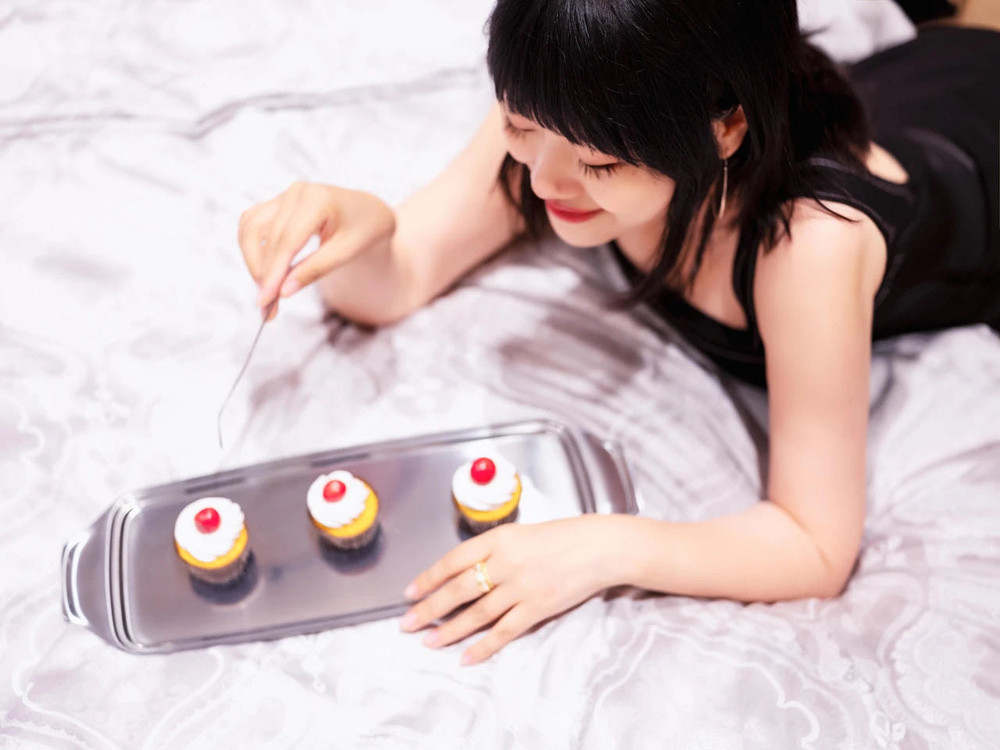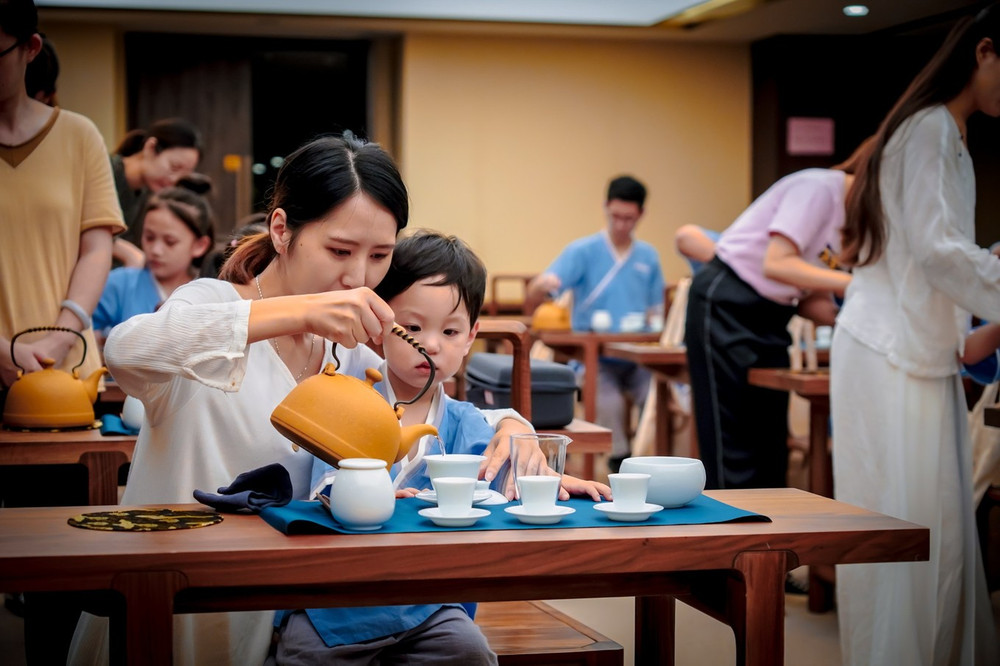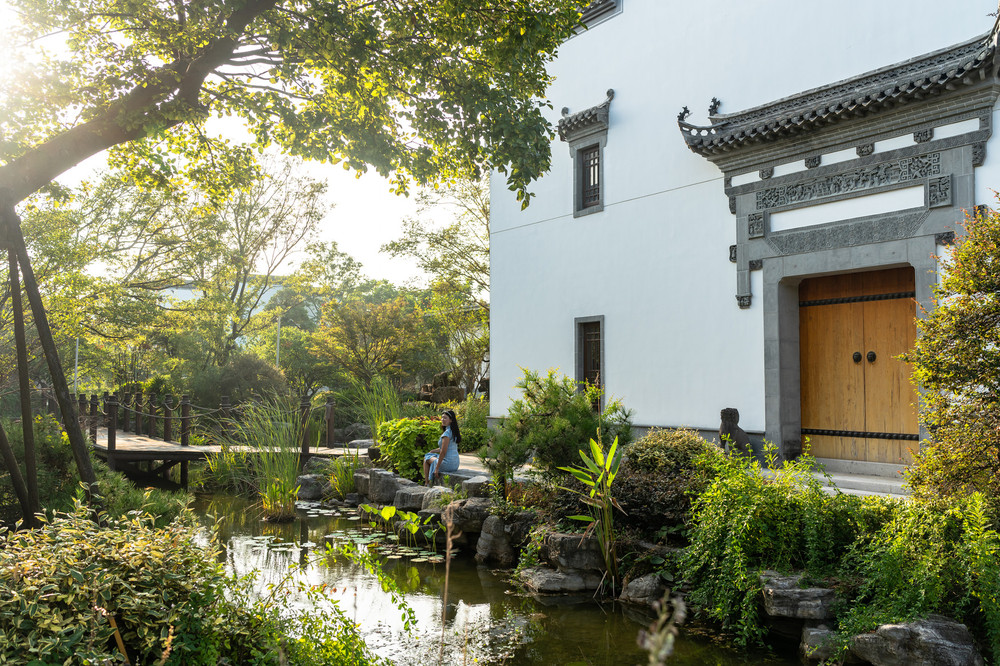The pandemic has changed many people’s work and life, but it has had little impact on creators, as most of their time is spent at home, unless there is official business that requires going out. My ideal home should be a CBD office, a family vacation spot, a hermitage, a living room for friends, an inspiration G-spot, and a museum of quirks. After the pandemic, home is the space that can accommodate all identities, tolerating my most private personality split. For creators, the most important thing is to have a place that can quietly accommodate all ‘personalities’, because it’s impossible to follow the rules, the ‘personality’ of home is more complex than the hundred Hamlets in a hundred people’s hearts.

I chose the profession of ‘eating’ and ‘writing about eating’, which seems easy to support, but going out to eat often leads to overly arranged meals, and the ‘right to choose’ is passively lost. Only by cooking at home can I regain functionality and experience the rare joy of freedom. If my greed is understood, it would be best if every part of the home was delicious, even the bookshelves could be a library where flavors can be randomly drawn, and as for the kitchen and household appliances, they should have both functionality and peculiarity.
For people living a normal life, ‘comfort and freedom’ need to be considered in every aspect; home is a collection of diverse ‘selves’. Diverse ‘selves’ and gourmet life. Recently, I have been studying ancient European cookbooks, and I have made the Italian national quick bread, Focaccia. The word Focaccia originates from the Latin word ‘focus’, which means ‘center’ or ‘oven’, because ovens were often built in the center of a house in ancient times. It is an ancient European bread and a very simple high-temperature quick-baked bread.
I used a combination of heavy oil, but it was a combination of olive oil and flaxseed oil, which I wrote about in my ‘Vegetable Oil Atlas’ in 2016. In fact, quick high temperature is a good way to retain nutrition, but unfortunately, ordinary ovens tend to heat up slowly, and even at high temperatures, the temperature control fails. The original focaccia bread recipe may have originated from the ancient Italian nation of Etruria or ancient Greece. People usually use olive oil and herbs for seasoning, sometimes covering the bread with cheese, meat, or various vegetables. Focaccia bread is actually the ancestor of pizza, which was baked in wood-fired ovens, and the temperature could reach several hundred degrees Celsius at once.
I first realized the importance of this function when I made Spak burnt cheese; otherwise, it would not be possible to have a soft inside and a fully cooked outside! So far, I only know that ASKO, a high-end appliance brand, can meet this requirement. The high-temperature pyrolytic oven can reach up to 275 degrees Celsius. The biggest advantage of this oven is the cleaning method, which leaves no chemical residue. It has a built-in high-temperature pyrolytic automatic cleaning program that can heat up to 465 degrees Celsius, burning all food residues into ashes, and the ashes left after pyrolysis are very easy to remove. However, not all foods need to be ‘burnt’, and for beginners, the anti-burn function is very useful!
For this reason, I have specially compared the differences between ASKO’s microwave oven and the ordinary oven, the most important of which lies in the inverter system of ASKO’s microwave oven. ASKO’s inverter system: Always working, using lower power – energy-saving. Lower microwave amplitude, more uniform. Achieving perfect cooking results, food will not be over-baked. Traditional system: Full power operation, maximum power or 0, no intermediate power levels. Food is prone to over-baking because there is only the highest power. Intermittent operation, cannot accurately reach the set power. There are too many breads that do not need to be burnt.
In recent days, I have used a liquid starter to make Italian Ciabatta bread and Panettone bread respectively. Both are very traditional. The ancient Egyptians began to bake bread 3000 years ago, but they did not know that modern people do not like to eat a lot of the same bread at one time. It is best to have multiple different flavors at one time. Of course, a simple and crude earthen oven won’t do, but how can an ordinary household oven bake different breads separately at one time?! What gives me a headache is that each type of bread has different fermentation times, baking temperatures, and durations. Ciabatta bread is one of the representative breads of Italy. The baking time is relatively fast, at 220 degrees to 200 degrees for about 30 minutes. The freshly baked shape is very much like a slipper. Made with a “liquid starter” that undergoes long-term low-temperature fermentation, the bread has shiny holes of different sizes in its texture. The crispy outside and soft inside taste becomes more fragrant the more you chew.I have so many reasons to indulge in this culinary delight. The traditional method is to dip it in Italian vinaigrette, while Europeans often prefer it in sandwiches. My American friend once shared a kalamata olive ciabatta with me, and I’m eager to try it with better pickled black olives. Speaking of which, panettone is a must during Christmas.
My liquid starter is incredibly soft, and when poet Zhao Ye tasted it, he remarked, “At this moment when I eat this cake, it’s just right.” To achieve perfection, the oven is set at 160 degrees with upper and lower heat for 30 minutes. Juggling two types of bread means using the oven twice, and ensuring the waiting bread doesn’t over-ferment is quite a challenge. My ideal oven would combine the functions of a traditional multifunctional oven with high-temperature pyrolysis, steaming, baking, and micro-baking capabilities. Ideally, it would allow me to ferment and bake different breads simultaneously, ensuring no one’s time or taste is delayed. ASKO has met these high standards, with its ability to bake on five layers and a temperature control precise to 1 degree.
ASKO’s history spans a century, with nearly 70 years dedicated to manufacturing and selling household appliances. Founded in 1918 by Aukusti Asko-Avonius, the brand has earned countless recommendations. Its 60cm/45cm height ensures that tall toast doesn’t overheat, and the segmented baking function is perfect for my light cheese that needs baking followed by coloring. With hundreds of automatic program recipes built in, there’s no shortage of variety. The steaming and baking integrated machine boasts a large capacity, and the 1.3-liter water tank can provide 80 minutes of full steam cooking, ideal for steaming a whole three-pound fish. The micro-baking integrated machine, with a 50-liter capacity, allows for simultaneous microwave and oven use, offering unparalleled flexibility.
Luxury in life is not about expense but about being “alive.” It’s about the essence of creation and the attention to detail, much like my friend Liu Zhanqun’s近乎 fanatical approach to photography. He waits for the perfect light, mood, and unfolding of events, mirroring the kitchen experience where the right temperature, humidity, and mood lead to perfect dough and inspired writing.
In daily life, there are countless moments to wait for, but to live a luxurious life at home, many things should be tailored-made to eliminate waiting. For instance, I rely on coffee and need different variations throughout the day. The ASKO built-in coffee machine, with eight options and a professional conical grinder, satisfies my personalized taste preferences. The EuroKera microcrystalline glass stovetop panel, with its fingerprint-resistant stainless steel surface and independent timer, is a godsend for cooking. And during the pandemic, the ASKO dishwasher, the world’s largest and most flexible, was a lifesaver, capable of holding up to 17 sets of standard Western dinnerware.
Last week, I had the pleasure of attending an ASKO luxury living private event as a food experience officer. There, I listened to three top luxury home designers discuss ‘The Art of Living’, and all the food was prepared using ASKO appliances. I’m excited to try them at home. On the menu: German style whole wheat bread with butter and cheese, and French classic chicken mushroom soup.Appetizer: Muslim crystal shrimp salad.
Main course: Imported truffle naked eye steak with secret French distilled red wine sauce.
Entree: Fragrant baked Boston lobster with vegetables.
Dessert: Plum sauce lime mousse pie with fruit.
At that dinner, I had the honor of meeting three brilliant designers, who, like me, are fans of ASKO and have a heart that is very ‘particular’ about life.
Food authors visited these places: Shanghai published on 2020-07-08 13:11 [Home]
The pandemic has changed the lives and work of many people, but it had little impact on creators, as most of their time was spent at home, unless there was a pressing need to go out for official business.
My ideal home would be: a CBD office, a family vacation spot, a hermitage, a meeting place for friends, a source of inspiration, and a museum of quirks… Post-pandemic, home is the space that contains all my identities, accommodating my most private personality splits.
For a creator, the most important thing is to have a place that can quietly embrace all ‘personalities’, as it’s impossible to follow the rules. The ‘personality’ of home is more complex than the hundred Hamlets in the hearts of a hundred people.
I chose the profession of ‘eating’ and ‘writing about food’, which seems easy to sustain, but when dining out, the ‘choice’ is often taken away from me. Only by cooking at home can I regain my functionality and enjoy the rare happiness of freedom.
If my greed is understood, then ideally, every part of my home would be delicious, even the bookshelf would be a library from which one can randomly draw flavors. As for the kitchen and household appliances, they should be functional, quirky, and versatile…
For those who live a normal life, ‘comfort and freedom’ need to be considered in every aspect, and home is a collection of diverse ‘selves’. Diverse ‘Selves’ and Personal Food Lifestyle
Recently, I have been studying ancient European cookbooks and have made Focaccia, the Italian national quick bread. The word ‘Focaccia’ originates from the Latin ‘focus’, meaning ‘center’ or ‘oven’, as ovens were often built in the center of a residence. It is an ancient European bread and is a simple, high-temperature, quick-baked bread.
I used a combination of heavy oils, specifically olive oil and flaxseed oil, which I wrote about in my ‘Vegetable Oil Atlas’ published in 2016. High temperatures are actually a great way to preserve nutrients, but unfortunately, ordinary ovens tend to heat up slowly and their temperature control fails at high temperatures.
The original Focaccia bread recipe may have originated from the ancient Italian state of Etruria or ancient Greece. People usually season it with olive oil and herbs, and sometimes add cheese, meat, or various vegetables on top.
Focaccia bread is actually the ancestor of pizza, which was baked in wood-fired ovens that could reach several hundred degrees Celsius at once. I first realized the importance of this feature when making Spaghetti Carbonara with burnt cheese, otherwise, it’s impossible to have a runny inside and a fully cooked outside!
So far, I only know that ASKO, a high-end brand, can meet this requirement, as their high-temperature ovens can reach up to 275 degrees Celsius.
The greatest advantage of this oven is its chemical-free cleaning method. It comes with an automatic high-temperature pyrolytic cleaning program that can heat up to 465 degrees Celsius, turning all food residues into ash that is easily removable.
However, not all food requires charring, and for beginners, the anti-burn feature is incredibly useful! To this end, I have specifically compared the differences between the ASKO microwave oven and a conventional oven, with the most significant difference being the inverter system of the ASKO microwave oven.
ASKO Inverter System: Always working, using lower power – energy-saving; microwave amplitude is lower and more uniform; achieving perfect cooking results without over-baking.
Traditional System: Full power operation, maximum power or 0, no intermediate power levels; food is prone to over-baking due to only having the highest power; intermittent operation, cannot precisely achieve the set power.
There are too many reasons not to have burnt bread.
Recently, I used a liquid starter to make traditional Italian Ciabatta and Panettone breads. The ancient Egyptians started baking bread 3000 years ago, but they didn’t know that modern people don’t like to eat a lot of the same bread at once; it’s better to have multiple different flavors at once.
A simple and crude earth oven is certainly not an option, but how can an ordinary home oven bake different breads separatelyMade with a liquid starter that has undergone long low-temperature fermentation, the bread has a texture with varying sizes of glossy holes, and a crispy exterior with a soft interior that becomes more fragrant the more it is chewed. I have too many reasons to eat it, with the traditional way being to dip it in Italian oil and vinegar. Europeans also often make sandwiches with it. An American friend shared with me the kalamata olive ciabatta, and once I have some good marinated black olives, I will definitely give it a try. Panettone is eaten during Christmas, and my liquid starter is very soft. When poet Zhao Ye tried it, he said, ‘At this moment when I taste this cake, everything is fine.’ Bake at 160 degrees for 30 minutes with both the top and bottom heat. I have to start the oven twice for these two breads, and in between, I also need to ensure that the waiting bread does not over-ferment, which is too difficult. Therefore, for the oven alone, I have many unreasonable demands. Ideally, it should not only achieve the traditional multi-function oven but also meet the requirements of high-temperature pyrolysis, steam baking, and microwave baking. Anyway, at least I can simultaneously complete fermentation and baking of different breads, so that no one’s time and taste are delayed! If the temperature control is strict, it can also be used as a fermentation box. As a result, ASKO has achieved this. I have been recommended many good things by ASKO. Since 1918, ASKO has become a brand with a century-long history, and the history of manufacturing and selling home appliances is nearly 70 years. In 1918, Aukusti Asko-Avonius (1887-1965), relying on the industrialized concept learned in Sweden, established the ASKO furniture factory in Finland. There are really countless reasons to recommend ASKO. It can achieve simultaneous baking of five layers. Then, the height of 60cm/45cm makes me not worry about the toast growing too tall and the upper layer being overheated. The segmented baking function is suitable for my light cheese that is first baked and then colored. In case there are not enough varieties of dishes, there are hundreds of automatic program recipes built in. The steam-oven combination has a huge capacity and there is no conflict with the baking function. Therefore, the temperature control is accurate to 1 degree. I no longer need to complain about the inaccurate temperature control of many domestic brands. The 1.3-liter water tank can meet 80 minutes of full steam cooking. I can steam a whole three-pound fish. The microwave-oven combination also has a large capacity of 50 liters. It can use microwave and oven functions simultaneously, extremely free! Luxurious life is not necessarily expensive, but it must be ‘alive’! The essence of creation is to regard everything as ‘alive’. Once I chatted with my friend Liu Zhanyun. He is a famous photographer, while I am a photography novice. I carefully observed his almost crazy obsession with details when taking pictures. He is waiting. He waits for the light, the mood, and the occurrence of things. He particularly values the trusting relationship with the photographed subject. This is similar to the feeling in the kitchen. When the temperature, humidity, and mood are right, and the dough is kneaded just right at this time, it is handy. When the inspiration for writing is waited for and the inner state is calm enough, it can be completed in one go. There are too many moments to wait in daily life. At home, to live a truly luxurious life, many things need to be customized. Preferably, there is no need to wait. For example, I can’t live without coffee. At home usually, I either stroll around the stove holding a coffee cup or read and write beside the coffee cup. So I have to drink different kinds of coffee in a day. ASKO’s built-in coffee machine has eight coffee options and can meet the need of making two cups of coffee at a time. There is no need to worry when guests come to play at home. The key is that there is also a professional conical grinder with 13 grinding levels to maximize the satisfaction of personalized taste needs. For me, a lazy person, the fingerprints on the gas stove are really annoying. EuroKera’s microcrystalline glass stove panel has a fingerprint-proof stainless steel panel. Equipped with an independent timer and automatic cooking functions, the stove boasts a powerful heat that can cook even the most impatiently desired hot tofu. Without a dishwasher, especially during the pandemic when housekeeping services are unavailable, I would be utterly distraught. The ASKO dishwasher outperforms all others in loading capacity, offering the largest and most flexible capacity in the world, capable of accommodating up to 17 sets of standard Western dinnerware. It featuresWhile listening to their sharing, I also recalled the time discussing lifestyles with the editorial team of AD. All the food that day was prepared using ASKO appliances, and I am eager to try them at home.
Bread / BREAD: German-style whole wheat bread with butter and cheese.
Soup / SOUP: French classic chicken and mushroom soup.
Appetizer / APPETIZER: Muslim crystal shrimp salad.
Main course / MAIN: Imported black truffle naked eye steak with a secret French distilled red wine sauce.
Main dish / ENTREE: Baked Boston lobster with vegetables.
Dessert / DESSERT: Plum sauce Limous pie with fruits.
That evening, I had the honor of meeting three brilliant designers who, like me, are fans of ASKO and have a heart that is very ‘fussy’ about life.
‘Oriental Collection Style’ – Botta Lai, who has won the 2019 German IF and Italian A’DESIGN Gold Design Award, and was also the most favored Chinese designer by Hurun Best in 2018. Mr. Lai Jian’an, the director of Shiyuan International Engineering Design from Taiwan, is known for designing luxury homes in the industry, but his works often do not show the usual sense of ‘luxury’. Instead, they convey a warm oriental aesthetic atmosphere. By carefully considering the collections of masters, he deeply perceives human scale and life details, and integrates them into the ‘home’ he designs, making each home a unique piece of art.
For designer Lai Jian’an, an extravagant home must embody ‘sunlight, air, life, and art’.
I am also fond of the work of the Italian designer Stefano Piontini, whose presentations are filled with childlike expressions and an abundance of creative thinking. Stefano Piontini graduated from the Polytechnic University of Milan with a master’s degree in architecture in 2011. During his time at university, he participated in two significant architectural innovation projects in Milan: Residenze Corso Como and Bosco Verticale. In 2017, with the support of the Italian Consulate General in Shanghai, he founded the ‘China-Italy Architects and Designers Alliance’. In 2019, he was recognized as one of the 100 most influential architectural design elites in China by the magazine ‘AD’ for his leading project ‘Golden Baby School and Office’, which was also voted the most popular project in its category.
A designer I particularly admire is Godfrey Lam, whose walk-in closet resembles a boutique, a design choice he says is loved by the women in his family. Above it is the bottom of his home’s swimming pool, allowing for scenic views and keeping an eye on the children while selecting clothes. Studio Glam was co-founded in 2017 by designers Godfrey Lam and Bryce Cai, with the philosophy that ‘life needs a touch of humor’. As the creative director of the studio, Godfrey Lam has received his education in Hong Kong, the UK, Canada, and the USA, majoring in architecture at Columbia University in New York. Throughout his career, Godfrey has never followed the crowd, consistently surprising the design community with personalized original designs and bold ideas. Over his 20-year career in the United States, he has worked for renowned global firms such as I.M. Pei, Rockwell Group, and HOK Asia Pacific. He has been involved in various projects from North America to Asia, including the 2009 Oscar award stage, President Trump’s New York hotel, and the restaurants of the world’s second-ranked Michelin chef Alain Ducasse in New York and Washington. Godfrey and Bryce are extremely sensitive to color, materials, and lighting, using them dramatically in their designs to create exclusive ‘life stages’ for their clients, making even the dishes at their dinner parties come alive with color and aroma.
We all need to make timely appearances in formal settings, and managing our attire can be quite a headache. In private conversations, Godfrey personally endorsed the ASKO washer, which is the only domestic drum washing machine in the world to use a four-way shock absorption support structure. The entire series of washing machines are equipped with high-end configurations, designed for a lifespan of over 20 years, and feature a washing and drying combination unit with far too many advantages to list. In 1950, ASKO introduced its first all-metal horizontal drum washing machine in Sweden, marking the beginning of its industrial production. Stainless steel inner and outer drums, cast iron supports, reversible motors, the ability to add both hot and cold water, and a spin-drying function are among the structures and features that have been carried over to this day. It is also the only domestic drum washing machine in the world to eliminate the design of a thick door gasket. The washing machine door is directly attached to the drum unit, thus avoiding the use of aThe drying function of the product is likely attributed to its Nordic origins, given the lengthy winters and the prevalence of snow sports in those regions. Often, clothing is not dirty and does not require washing, but the melting snow and ice leave garments damp, which can affect comfort. This necessity led to the invention of the drying cabinet. These cabinets are commonly installed in homes, schools, and some public areas to facilitate the quick drying of clothes.
Remarkably, the drying cabinet is suitable for all types of clothing, including sportswear, outdoorwear, work clothes, cashmere, leather, silk, shirts, velvet, satin, athletic shoes, boots, and rain shoes. It offers various drying options such as ‘hot air drying,’ ‘normal temperature,’ ‘low temperature,’ and ‘cold air drying,’ catering to the drying needs of different fabrics. The flexible internal space can extend to the length of a 16-meter clothesline. Additionally, the cabinet can be hung, allowing many clothes to dry naturally and stand upright, eliminating the need for ironing.
These unparalleled features make the drying cabinet particularly suitable for the humid climate of the south. As a person who finds contradiction in my nature—I grow bored in idleness and ache when busy—returning home is the remedy, especially for the ‘disease’ caused by an obsession with detail. If every detail in the home is to one’s liking, there is no need for vigilance and tension. Even the most fastidious geniuses and madmen would not mind.
The divine fortune teller inquires, “What do you think makes a home comfortable?” Home is the only place in the world that conceals human shortcomings and failures while also nurturing sweet love. —— Bernard Shaw
Food Bless You!
Consultant for the China International Food Expo
Producer of ‘The Divine Dining Table’









